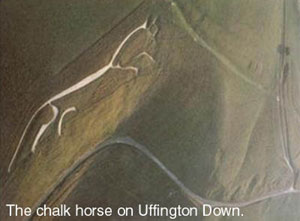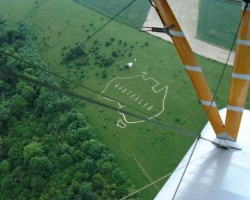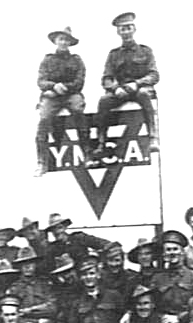|
|
|

|
 |
|||||||||||||
|
Fourteen miles
to the South of the Vale of the White Horse lies Hurdcott Hill where
Anzacs were encamped during WW1. As the native people of Britain did
thousands of years before, the Anzacs also left lasting images of the
things they held dear. The medals face North on the ridge that runs East West just to the South of a little village called Compton Chamberlayne on the A30 road. The distance from Salisbury is about 6 miles to the West. I don’t know if they are easy to spot from the road, you may have to buy a 1:25000 Ordnance Survey map and take footpaths. Bob Gauld-Galliers.
Aerial photos courtesy Bob Gauld-Galliers. |
These memorials, built by the soldiers themselves are maintained by The Fovant Badges Society. 
It is an on-going job, well deserving of your support. Browse their site, HERE. or Click on the' friends' logo above to make a donation to the society. |
|
 |
||
|
|
||
|
A closer look.
It has been said that the diggers made the carvings to keep warm and
it was necessary to melt snow for water because the pipes were frozen.
Could this be happening here?
|
||
| When I posted the above pictures, I was unaware of the Fovant Badges Society. This is a group of volunteers dedicated to the maintainence and restoration of these memorials. They need financial support to do so. See link above right. | ||
 |
||
 |
Obviously the YMCA took an active role in supporting the training and rehabilitation facilities of the Salisbury Plain. The YMCA must have made a lasting impression on the diggers. The carved logo certainly has. (above & left) |
|
 A.W.M. |
||
| Why the Salisbury Plain? This was the training destination for Australian troops bound for war in late 1914. According to historian Charles Bean wooden huts could not be improvised in time; training became a fight against the weather for bare health and existence and the camps (mainly tents) turned into archipelagoes of mud. Canadian troops, coming here, had little expected these miseries and reckless breaking of camp and disturbances in the old cathedral city of Salisbury were the result. The Australian contingent was diverted to Egypt to a rapidly constructed tent city at Mena in the shadow of the pyramids. Obviously, Anzacs later found their way to Salisbury after it had been constructed, for convalesence and training . | ||